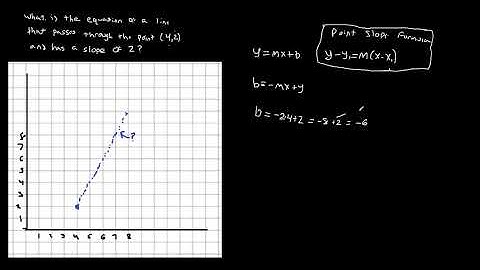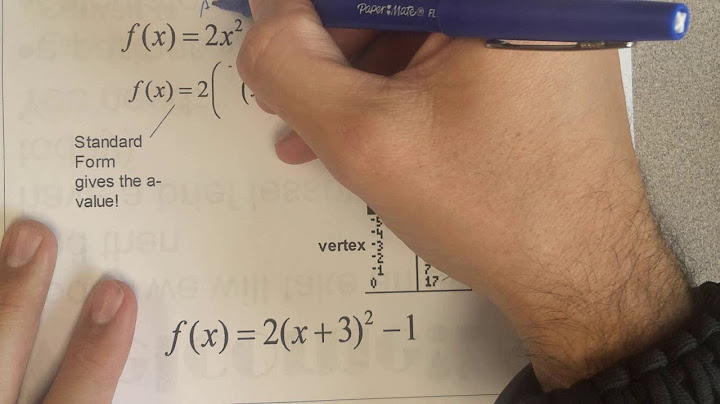 Show The standard form equation is a linear equation that contains two variables, usually (but not limited) to x-terms and y-terms, that are on the same sides of the equation: Ax + By = C Coefficients A, B, and C must be whole number integers that have no decimals or fractions. In the standard form equation, coefficients B and C can be positive or negative numbers, but coefficient A must be a positive number. Point-Slope, Slope-Intercept, and Standard Form EquationsA linear equation is the equation of a line on a graph. Linear equations come in different forms, like point-slope form and slope-intercept form. Let’s explain each of these forms. Standard form:  Writing an equation in standard form makes it easier to find the x and y-intercepts, which is where the graph crosses the x- and y-axis. All you have to do is plug in a 0 for the y to find the x-intercept or a 0 for the x to find the y-intercept. Point-slope form:  In point-slope form, x1 and y1 are coordinates of a point on a graphed line, and m is the line's slope. Slope-intercept form:  The slope-intercept form has the slope, m, and the y-intercept, b, on the right-hand side of the equation. Since this is a useful form, you’ll often be asked to convert an equation from standard form to slope-intercept form. So let’s show you how to do this. Converting Standard Form to Slope-Intercept Form Let’s convert the following standard form equation to slope-intercept form:  We want to isolate the y, so let’s start by subtracting 6x from both sides:  As you can see, you’re left with -2y on the left. Now, we must divide both sides by -2 to isolate the y:  Once you rearrange this equation to be in the y = mx + b format, this equation is in slope-intercept form:  How to Convert Standard Form EquationsAs we've stated, in standard form, equations coefficients A, B, and C must be whole numbers. Let's convert the below equation, which contains fractions and negative numbers, into a proper standard form equation:  The first step is removing the fractions from the equations. To do this, we must determine the common factors of the two denominators, -4 and 8. The least common denominator of these two numbers is 8, so let's multiple each side by this:  Now that all the coefficients in this equation are whole numbers, we need to convert -6 into a positive number. We can do this by multiplying both sides of the equation by -1:  Learning How to Write Standard Form EquationsStandard form is one of the three different ways to write linear equations. Finding common factors to convert equations with fractions into standard form equations makes it easier to move onto more complex math concepts, like graphing linear equations. More Math Homework Help
Hello! Today we are going to take a look at how to convert linear equations between standard form and slope-intercept form. As a reminder, the standard form of a linear equation is:
For a standard form equation, \(A\) must be positive, and both \(A\) and \(B\) must be whole numbers. And the slope-intercept form of a linear equation is:
This is called slope-intercept form because the equation itself tells you the slope (\(m\)) and the \(y\)-intercept (\(b\)). So let’s start with a simple example. Convert the standard form equation \(x+y=2\) to slope-intercept form. To convert from standard form to slope-intercept form, all we have to do is rearrange our equation to solve for \(y\) and then double check that our terms are in the correct order. So to do that with this equation, we have to subtract \(x\) from both sides.
When we do that, our \(x\)‘s cancel out and we’re left with:
Now, this is almost correct, but remember, slope-intercept form is \(y=mx+b\). That means that our \(x\)-term needs to be first. Because of the commutative property of addition, we know that we can swap our two terms on the right side of our equation. So that will give us:
Notice that I kept the signs with each of the numbers, so we have minus \(x\) up here and that becomes \(-x\), and our 2 is positive up here and that becomes \(+2\). Making sure your signs are correct is super important when you do this. So now, because our equation is in slope-intercept form, we can easily see that our slope, \(m\), is equal to \(-1\), and our \(y\)-intercept, \(b\), is equal to 2. Let’s try another one! Convert \(2x-3y=6\) to slope-intercept form. The first thing we need to do is solve our equation for \(y\). We can start by subtracting \(2x\) from both sides of our equation.
So our \(2x\)‘s cancel out over here, and we’re left with:
Now, we divide both sides by \(-3\).
We need to divide the entire right side by \(-3\), so this means that each term needs to be divided by \(-3\). It’s easy to want to only divide 6 by \(-3\), but this will give you an incorrect answer. So make sure you also divide \(-2x\) by \(-3\). So over here on our left side, our \(-3\)‘s cancel out and we’re left with \(y\) equals, \(6\div (-3)=-2\), because a positive divided by a negative is a negative. And then \(-2x\div (-3)=\frac{2}{3}x\), because a negative divided by a negative is equal to a positive.
So we almost have our correct answer, but we need to switch our terms on the right side. So that will give us:
And we can see that our slope, \(m\), is equal to 23, and our \(y\)-intercept, \(b\), is equal to \(-2\). But what if we want to go the other way and convert a slope-intercept form equation to standard form? Let’s take a look at an example! Convert \(y=-4x+7\) to standard form. Remember, standard form is \(Ax+By=C\). To convert to this form, all we have to do is bring our \(x\)-terms to the left side of the equation, then we’ll make sure our \(A\)-value is positive and both our \(A-\) and \(B-\) values are whole numbers. So, to move this \(x\)-term to the left side of the equation, for this problem, we’re going to add \(4x\) to both sides.
Our \(4x\)‘s will cancel out on the right side, and on the left side we’re left with:
Now we use the commutative property of addition to swap our terms on the left side and get:
Finally, we check to make sure our \(A\)-value is positive and our \(A-\) and \(B\)-values are whole numbers. Both of these things are true, so this is our final answer. Let’s try one more example. Convert \(y=\frac{4}{7} x-9\) to standard form. For this equation, we’re going to start by multiplying the entire equation by 7 so that we can get rid of this fractional term..
So, \(7\cdot y=7y\). \(7\cdot \frac{4}{7}x\), our 7’s will cancel out and that’ll leave us with \(4x\). And \(7\cdot 7(-9)=-63\).
So again, we’re going to bring our \(x\)-terms to the left side of the equation by subtracting \(4x\) from both sides.
So that gives us:
Now we’re going to swap our terms on the left side using the commutative property of addition to get:
Finally, we make sure that \(A\) is positive and both \(A\) and \(B\) are whole numbers. \(A\) is negative, so we need to deal with this first. To get rid of the negative in front of \(A\), we multiply the entire equation by \(-1\).
When we do this, we’ll get, \(-1\cdot (-4x)=-4x, -1\cdot 7y=-7y\), and \(-1\cdot (-63)=63\).
Now, our \(A\)-value is positive, and both \(A-\) and \(B\)-values are whole numbers, so this is our final answer. I hope this video helped you better understand how to convert between standard form and slope-intercept form of linear equations. Thanks for watching and happy studying! Practice QuestionsQuestion #1: \(8x-2y=-3\) \(8x+2y=3\) \(4x+2y=6\) \(4x-2y=-6\) Show Answer Answer: The equation of a line in standard form is: \(Ax+By=C\)
First, let’s clear out the fraction for the equation of our line that is in slope-intercept form by multiplying both sides of the equation by the denominator of the fraction. In this case, multiply both sides of the equation by 2. \(2\cdot y=2(-4x+\frac{3}{2})\) \(2y=2(-4x)+2\cdot \frac{3}{2}\) \(2y=-8x+3\) Now, move the x-term to the left-hand side of the equation by subtracting \(8x\) from both sides. \(2y+8x=-8x+3+8x\) Hide Answer Question #2: \(y=\frac{2}{7}x-2\) \(y=-\frac{2}{7}x+2\) \(y=\frac{7}{2}x-14\) \(y=-\frac{7}{2}x+14\) Show Answer Answer: The given equation is in standard form. The equation of a line in slope-intercept form is: \(y=mx+b\)
To convert the equation of our line to slope-intercept form, we need to isolate the \(y\)-value. Start by subtracting \(2x\) from both sides. \(2x-7y-2x=14-2x\) Next, divide both sides by –7. \(\frac{-7y}{-7}=\ \frac{14-2x}{-7}\) \(y=-2+\frac{2}{7}x\) Rearranging the terms on the right-hand side of the equation, we get: \(y=\frac{2}{7}x-2\) Hide Answer Question #3: \(3x-5y=-2\) \(5x+3y=2\) \(3x-5y=10\) \(3x-5y=-10\) Show Answer Answer: The given equation is in slope-intercept form. The equation of a line in standard form is: \(Ax+By=C\)
First, let’s clear out the fraction for the equation of our line by multiplying both sides of the equation by the denominator of the fraction. In this case, multiply both sides of the equation by 5. \(5\cdot y=5(\frac{3}{5}x-2)\) \(5y=5\cdot\frac{3}{5}x-5\cdot2\) \(5y=3x-10\) Next, we need to be sure the terms containing \(x\) and \(y\) are on the left-hand side of the equation. To do so, subtract \(3x\) from both sides. \(5y-3x=3x-10-3x\) In the standard form equation of a line, A must be greater than zero. So, multiply both sides of the equation by –1. \(-1(-3x+5y)=-1\cdot-10\) Hide Answer Question #4: \(75-y=-25x\) \(75+y=25x\) \(25x-y=-75\) \(25x+y=75\) Show Answer Answer: The equation of a line in standard form is: \(Ax+By=C\)
First, we need to be sure the terms containing \(x\) and \(y\) are on the left-hand side of the equation. So, subtract \(25x\) from both sides of the equation. \(y-25x=25x+75-25x\) In the standard form of a line, \(A\) must be greater than zero. So, multiply both sides of the equation by -1. \(-1(-25x+y)=-1\cdot75\) Hide Answer Question #5: \(y=-\frac{2}{3}x+\frac{100}{3}\) \(y=\frac{2}{3}x-\frac{100}{3}\) \(y=-\frac{2}{3}x+100\) \(y=\frac{2}{3}x-100\) Show Answer Answer: The equation of a line in slope-intercept form is: \(y=mx+b\)
First, let’s clear out the fraction for the equation of our line by multiplying both sides of the equation by the least common multiple of the two denominators. The least common multiple of 5 and 10 is 10, so multiply both sides of the equation by 10. \(10(\frac{1}{5}x+\frac{3}{10}y)=10\cdot10\) \(10\cdot\frac{1}{5}x+10\cdot\frac{3}{10}y=100\) \(2x+3y=100\) To convert the equation from standard form to slope-intercept form, we need to isolate the \(y\)-value. Start by subtracting \(2x\) from both sides. \(2x+3y-2x=100-2x\) Then, divide both sides of the equation by 3. \(\frac{3y}{3}=\frac{100-2x}{3}\) Rearranging the terms on the right-hand side of the equation, we get: \(y=-\frac{2}{3}x+\frac{100}{3}\) Hide Answer How do you convert standard form to slope intercept?Convert the standard form equation x+y=2 to slope-intercept form. To convert from standard form to slope-intercept form, all we have to do is rearrange our equation to solve for y and then double check that our terms are in the correct order. So to do that with this equation, we have to subtract x from both sides.
|

Related Posts
Advertising
LATEST NEWS
Advertising
Populer
Advertising
About

Copyright © 2024 paraquee Inc.


















